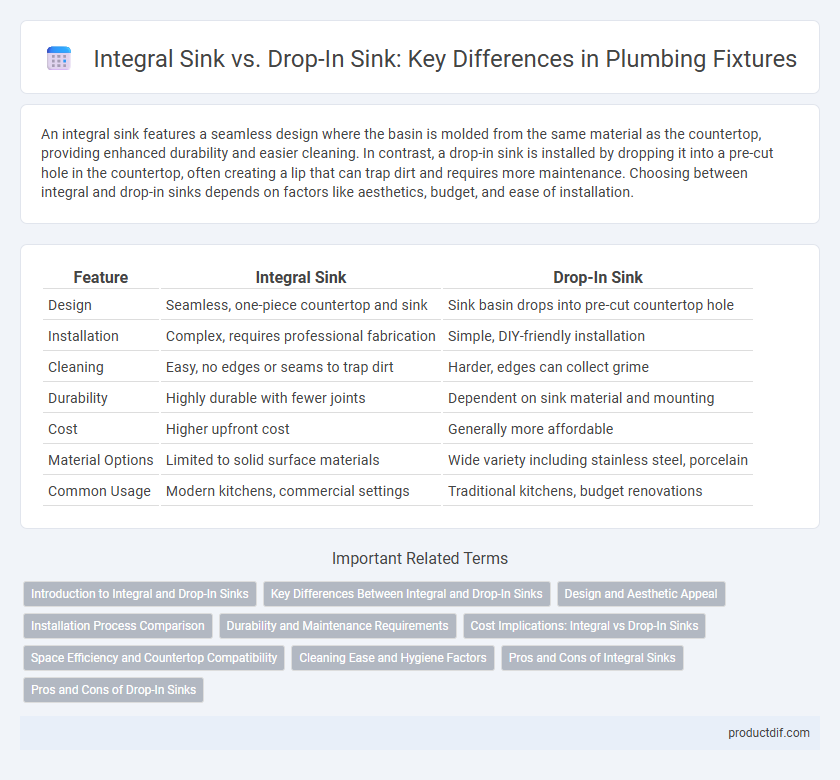An integral sink features a seamless design where the basin is molded from the same material as the countertop, providing enhanced durability and easier cleaning. In contrast, a drop-in sink is installed by dropping it into a pre-cut hole in the countertop, often creating a lip that can trap dirt and requires more maintenance. Choosing between integral and drop-in sinks depends on factors like aesthetics, budget, and ease of installation.
Table of Comparison
| Feature | Integral Sink | Drop-In Sink |
|---|---|---|
| Design | Seamless, one-piece countertop and sink | Sink basin drops into pre-cut countertop hole |
| Installation | Complex, requires professional fabrication | Simple, DIY-friendly installation |
| Cleaning | Easy, no edges or seams to trap dirt | Harder, edges can collect grime |
| Durability | Highly durable with fewer joints | Dependent on sink material and mounting |
| Cost | Higher upfront cost | Generally more affordable |
| Material Options | Limited to solid surface materials | Wide variety including stainless steel, porcelain |
| Common Usage | Modern kitchens, commercial settings | Traditional kitchens, budget renovations |
Introduction to Integral and Drop-In Sinks
Integral sinks feature a seamless design where the sink and countertop are molded together, offering enhanced durability and easy cleaning due to the absence of seams. Drop-in sinks are installed by inserting the basin into a pre-cut hole in the countertop, providing straightforward installation and the option to easily replace or upgrade. Both options vary in materials and styles, influencing aesthetic appeal and maintenance requirements for residential and commercial plumbing fixtures.
Key Differences Between Integral and Drop-In Sinks
Integral sinks feature a seamless design where the sink basin and countertop are molded as a single piece, ensuring easy cleaning and a modern aesthetic, while drop-in sinks are installed by fitting into a cutout on the countertop with a visible rim, allowing for simpler replacement and installation. Integral sinks often use materials like cultured marble or solid surface for durability and style continuity, whereas drop-in sinks are commonly made of stainless steel, porcelain, or composite materials, offering more variety in shapes and sizes. The choice between integral and drop-in sinks impacts maintenance, customization, and overall bathroom or kitchen design integration.
Design and Aesthetic Appeal
Integral sinks offer a seamless, sleek design by combining the basin and countertop into one continuous surface, creating a modern and minimalist aesthetic. Drop-in sinks feature a visible rim resting on the countertop, allowing for more traditional or varied design styles with easier installation and replacement options. The choice between the two impacts the overall visual flow and customization potential of bathroom or kitchen spaces.
Installation Process Comparison
Integral sinks feature a seamless design that combines the sink basin and countertop, requiring precise fabrication and professional installation to ensure a watertight fit. Drop-in sinks are easier to install, as they simply drop into a pre-cut hole in the countertop, secured with clips and silicone sealant, making them suitable for DIY projects. Installation time for integral sinks is longer due to custom measurements and adhesive curing, while drop-in sinks offer quicker, more flexible installation options.
Durability and Maintenance Requirements
Integral sinks offer superior durability due to their seamless construction, eliminating joints where leaks and cracks commonly occur. Drop-in sinks, while easier to replace, require regular sealing and maintenance around the rim to prevent water damage and mold growth. The solid surface material of integral sinks typically resists stains and scratches better, reducing long-term upkeep efforts compared to the often more vulnerable drop-in designs.
Cost Implications: Integral vs Drop-In Sinks
Integral sinks often come with higher initial costs due to the seamless design and material quality, increasing overall bathroom or kitchen remodeling expenses. Drop-in sinks typically offer lower upfront costs and easier installation, making them a budget-friendly option for many homeowners. Long-term maintenance and potential replacement costs also tend to be lower with drop-in sinks, impacting the total cost of ownership.
Space Efficiency and Countertop Compatibility
Integral sinks offer superior space efficiency by seamlessly combining the sink and countertop, eliminating gaps where debris can collect and maximizing usable counter area. Drop-in sinks require a pre-cut hole and sit on top of the countertop, which can limit design flexibility and reduce available workspace around the sink. Compatibility with various countertop materials is greater for drop-in sinks, while integral sinks typically require specific composite or solid surface materials for a cohesive, leak-resistant installation.
Cleaning Ease and Hygiene Factors
Integral sinks feature a seamless surface with no crevices, significantly reducing the buildup of dirt and bacteria, which enhances cleaning ease and overall hygiene. Drop-in sinks have edges where grime and mold can accumulate, requiring more meticulous cleaning to maintain sanitary conditions. The non-porous materials used in integral sinks further contribute to their resistance to stains and microbial growth, promoting a more hygienic kitchen or bathroom environment.
Pros and Cons of Integral Sinks
Integral sinks offer a seamless design that eliminates crevices, reducing mold and grime buildup, which enhances hygiene and simplifies cleaning. Their unified material composition provides superior durability and a sleek, modern aesthetic but limits customization options and can be costly to replace if damaged. While integral sinks prevent leaks commonly found in drop-in installations, they require professional installation and pose challenges for repairs compared to the easily replaceable drop-in sinks.
Pros and Cons of Drop-In Sinks
Drop-in sinks offer easy installation and replacement, fitting securely on the countertop with a visible rim that helps contain water spills. They provide versatility in design and are typically more affordable than integral sinks, but the raised edges can collect dirt and grime, requiring more frequent cleaning. Their exposed rim may also disrupt a sleek countertop appearance, making them less ideal for modern, seamless kitchen designs.
integral sink vs drop-in sink Infographic

 productdif.com
productdif.com